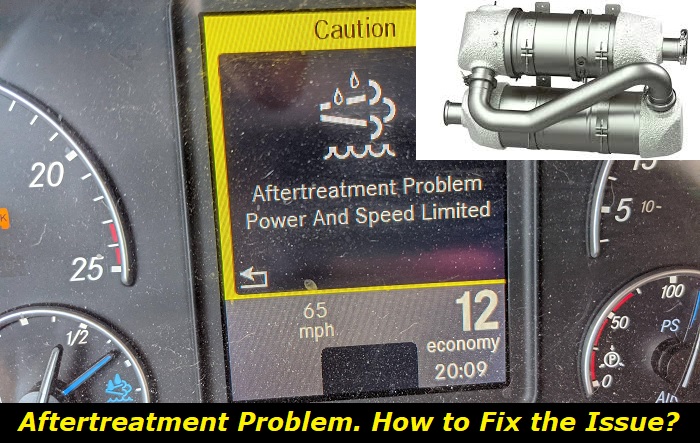"Aftertreatment Problem: Power and Speed Limited" in My Truck. What's This?
If you roll around in a truck often, then you know how important it is that your engine runs at top condition all the time. You know better than anyone that your truck is an important tool. You might just use it to transport wood or parts around, or it could be the main source of your income. Either way, it's a big pain when it doesn't run like it should.
One problem that could cripple your truck is an aftertreatment problem. This is an issue with the system that reduces your truck's emissions. Also, probably more importantly, it increases your engine's efficiency. If something goes wrong with it, then your truck will produce less power than normal.

What is Aftertreatment?
Let's talk about aftertreatment first. Aftertreatment is used in modern diesel engines to cut out toxic emissions and boost your fuel efficiency.
This important system works using two complicated systems. You have the Diesel Particulate Filter (DPF), which captures soot from the exhaust. Soot quickly builds up on this filter, but the system has a way of dealing with it. Once the filter is full, the system carries out a DPF regeneration. Regeneration cleans the DPF by burning off the soot, preventing a blockage.
There's also the Selective Catalyst Reduction (SCR) system that uses chemical catalysts to break harmful gases into harmless nitrogen and water.
Aftertreatment problems usually come from one of these systems failing. However, there are other issues that can cause aftertreatment problems to come up.
What is an Aftertreatment Problem?
When your aftertreatment system fails, you'll notice a whole slew of problems pop up in your engine. The most obvious is the "aftertreatment problem: power and speed limited" warning message. This is usually followed by a marked drop in your engine's performance.
What Does an Aftertreatment Problem Do to Your Truck?
If something goes wrong with your aftertreatment system, it can have serious effects on your engine. The most obvious issue is that the power and speed of the engine will be reduced, just like it says in the warning.
The main way this happens is through increased backpressure in the engine. This is when the aftertreatment system can't get rid of exhaust gases effectively. This can hinder combustion in the engine, or even cause the engine to suck in exhaust.
When the "aftertreatment problem: power and speed limited" warning comes up, it means that an issue with your aftertreatment system is affecting your engine and limiting its output. You can't afford to ignore this, because the problem could worsen and lead to very expensive repairs.
You should try to get your aftertreatment problem fixed as soon as possible.
What Causes an Aftertreatment Problem?
If you don't want your truck to end up as dead weight, you'll need to do something about your aftertreatment problem. The first step to getting that done is figuring out what went wrong with your aftertreatment system.
1) Clogged DPF
The DPF works like any other filter in an engine. It can get clogged once it blocks up too much dirt. Unlike other filters, it's self-cleaning through the regeneration process.
DPF regeneration isn't perfect though. When the soot in the DPF is burnt up, it leaves behind a little ash. This ash will eventually build up, clogging up the DPF and cutting off exhaust flow.
2) DEF Problems
Another issue that can cause aftertreatment problems is when you have an issue with your Diesel Exhaust Fluid (DEF). DEF is the fluid used in the SCR system. Chemically speaking, it's a combination of deionized water and urea.
Normally DEF works to break down harmful gases in your exhaust, but it might not do its job if something is wrong. There are two main issues that can arise with your DEF.
- Low DEF: This is simple, but often overlooked. If you don't have enough DEF in the tank, then your aftertreatment system won't be able to clean out your exhaust gases effectively.
- Contaminated DEF: DEF is formulated to give you a specific ratio of water to urea, right out of the can. It's very sensitive to contamination, and anything that throws off this ratio or introduces foreign chemicals can prevent it from working properly. Contaminated DEF can also clog the DEF injector and damage components in the SCR.
You can test for contamination using a digital refractometer. Good DEF will have a purity of 32.5 to 27% urea.
3) Engine Problems
Aftertreatment problems don't always stem from the aftertreatment system itself. The system is designed to work with a healthy engine. This means that engine problems can mess with the aftertreatment components and cause poor performance in both systems.
There are a lot of things that can go wrong with an engine, but we'll list out the ones that affect the aftertreatment system.
- Engine oil overconsumption can prematurely clog the DPF with ash. If you're constantly running into aftertreatment problems and your engine oil runs out quickly, you should have a mechanic check your engine oil consumption.
- Coolant consumption is another issue that can contaminate DEF. If your coolant system starts to leak, coolant can get into the DEF, contaminating it and ruining its effectiveness.
How Can I Fix an Aftertreatment Problem?
Here are some steps you can take to fix your aftertreatment issues and get your truck back to full performance.
1) Regenerate the DPF
Some engines regenerate automatically when the car detects that the DPF is starting to get blocked up. Not all engines regenerate automatically though.
Even with auto regenerating diesel engines, there are some times a regeneration will fail. This is particularly common in trucks that start and stop often along their routes. It's also common in trucks that don't reach high speeds often. The exhaust doesn't get hot enough or run long enough for the regeneration process to fully take place. This will eventually result in your DPF being overloaded with soot.
If your engine doesn't regenerate automatically, or it fails a regeneration, then you'll have to regenerate the DPF manually. The exact process is different for each vehicle, so your best bet is to get a trusted mechanic to handle it for you.
2) Change Your DPF
Diesel particulate filters will eventually need to be replaced, just like any other filter. Even with frequent regenerations, there's a build-up of ash that can't be removed easily.
You won't have to change your filter too often, it has a longer lifespan than an oil filter or air filter. That said, you should make sure to change it on time, according to the owner's manual for your vehicle.
If you have aftertreatment problems, changing the filter might just be the fix you're looking for.
3) Replace or Top Up Your DEF
If your aftertreatment problems are being caused by low DEF, you won't need to worry. You can easily fix the issue by adding more DEF to the tank.
Contaminated DEF, on the other hand, is a much more involved process to fix. You'll need to drain the DEF tank and clean it out with deionized water. You'll also need to flush the DEF system using deionized water. This is important because you need to remove all traces of the contaminated DEF.
After flushing the system, you can fill up the DEF tank again. Make sure to use new, clean DEF, and dispose of the contaminated DEF properly. Always dispose of DEF in accordance with local laws.
How Can I Avoid Aftertreatment Problems?
Aftertreatment problems are a real pain, especially if you rely on your truck to make a living. Days of downtime can translate to hundreds or even thousands of dollars of income lost.
Fortunately, you can actually prevent aftertreatment problems from developing in your engine.
- Don't idle your engine more than necessary. This needlessly taxes the aftertreatment system, meaning you'll need to regenerate and replace your diesel particulate filter more often.
- Take good care of your engine and perform maintenance often. Keep an eye on the level of engine oil and other fluids in your engine. You should also deal with any warning lights as soon as possible.
Remember that the aftertreatment system is downstream from the engine, so any problems with the engine can cause problems with the aftertreatment.
Bottom Line
The aftertreatment system is a vital part of any diesel engine that cuts down on emissions. A problem with the engine can cause issues in the aftertreatment system, and vice versa. If you get the "aftertreatment problem: power and speed limited" warning, then there's a problem causing your aftertreatment system to fail.
Aftertreatment problems can cause a blockage in the exhaust system, which can cause damage to the engine. You should deal with these issues as soon as possible to save your truck from expensive repairs down the line.
The most common causes of aftertreatment problems are problems with the diesel particulate filter, low or contaminated DEF, or engine problems. Inspecting these systems and dealing with the underlying problem will get your aftertreatment system back in working order.

Add comment